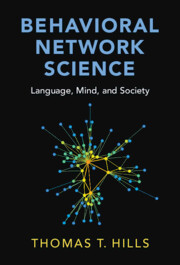Book contents
- Frontmatter
- Contents
- Additional Resources
- Introduction: Structure Matters
- Part I A Brief Guide to Network Science
- Part II Language
- Part III Mind
- 10 False Memories: Spreading Activation in Memory Networks
- 11 Cognitive Foraging: Exploration versus Exploitation
- 12 Age-Related Cognitive Decline: A Network Enrichment Account
- 13 Creativity: How Noisy Processes Create Novel Structure
- Part IV Society
- References
- Index
13 - Creativity: How Noisy Processes Create Novel Structure
from Part III - Mind
Published online by Cambridge University Press: 08 November 2024
- Frontmatter
- Contents
- Additional Resources
- Introduction: Structure Matters
- Part I A Brief Guide to Network Science
- Part II Language
- Part III Mind
- 10 False Memories: Spreading Activation in Memory Networks
- 11 Cognitive Foraging: Exploration versus Exploitation
- 12 Age-Related Cognitive Decline: A Network Enrichment Account
- 13 Creativity: How Noisy Processes Create Novel Structure
- Part IV Society
- References
- Index
Summary
Compared to people who are rated as less creative, more creative people tend to produce ideas more quickly, with more novelty, and more actively engage regions of the brain associated with cognitive control. Both inside and outside the laboratory, the evidence is clear: the creative mind is a productive mind. Structural analysis of what more creative people produce has led to two different proposals for how this is achieved. One is based on differences in the underlying knowledge representation – the structure of semantic memory – called the associative theory of creativity. The other is based on more effortful cognitive control – how semantic memory is accessed – called the executive theory of creativity. Evidence supports both, but there are few models integrating these two ideas. Network analysis offers some inroads into how to tackle this problem and invites some creativity of its own.
Keywords
Information
- Type
- Chapter
- Information
- Behavioral Network ScienceLanguage, Mind, and Society, pp. 203 - 224Publisher: Cambridge University PressPrint publication year: 2024
